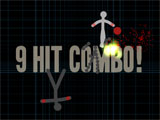A Brilliant Physics Game: Ski Stunt Simulator
Ski Stunt Simulator may very well be my all-time favorite physics game. As with most physics games, the premise is simple: You control a 2D skier performing various tricks on the slopes. Where Ski Stunt Simulator stands apart from other physics is the fidelity of that control. This isn’t a simple ragdoll game–far from it. In fact, Ski Stunt Simulator is the result of collaboration between a programmer at Relic Entertainment and a researcher at the University of British Columbia, and the robust simulation definitely demonstrates an academic level of engineering.
The game’s authors describe Ski Stunt Simulator as:
This project implements a realistic planar simulation of the physics involved in performing acrobatic ski stunts. The pose of the skier can be interactively controlled with the mouse. Thus performing any given stunt requires the right combination of both physics and skill, as in real life. A large variety of stunts can be performed, including anything ranging from a triple back flip to a triple front flip. The resulting simulator can be viewed as a game, a teaching tool for kinesiology, or as a preliminary sports prototyping tool.
I prefer to view the resulting simulator as a game. And a damn fun one, too, even if it is a little frustrating at first. Control of your skier is mapped to the X and Y axis of the mouse. Move the mouse up, and your skier straightens out. Move it down and he’ll crouch. Move it left and right and he’ll lean forward and backward. In combination these two axes result in a wide range of motion. Holding the mouse in the bottom-right position will result in a classic skier’s tuck, for instance.
Each limb and component of your character has proper inertia. To “jump” you simply start with the mouse towards the bottom of the screen and then quickly slide it up. To “flip” you start in the lower-left and do an arc of sorts; the upwards motion results in air time and then you move the mouse to the bottom-right to tuck into a rotation. You simply extend your skier’s body to slow the rotation and time the landing, approximately as you would in real life.
It sounds complicated, at first, but after a few hours of play it becomes strangely second nature. The game features an excellent monkey-see, monkey-do tutorial to teach you the basics. It doesn’t take long before you’ll be landing crazy triple flips. Click the Flash video below for a demonstration of one of the stages:
The game features 14 levels. The skills and tricks required to pass each level vary. One level will require you perform a backflip on a certain jump, another will require clearing a stack of crates, and another will be to simply make it to the bottom of the hill–dead or alive.
Thankfully, crashing in Ski Stunt Simulator is hilarious fun. It mitigates the harsh learning curve of the game. Even if you can’t nail that double backflip you need to pass the level you can still chuckle as your skier breaks each and every bone in his body. As the sometimes-irritating voice over would say, “Good thing it’s just a simulation!”.
The game has an unfinished feel in some areas. Some aspects of the game are much more complete than others. There is an excellent custom course designer as one of the levels, but unfortunately there’s no way to save your creation to share with others. You can, however, save recordings of levels and give them to your friends. When the game was first released there was a small archive of interesting runs.


(Ski Stunt Simulator Game Screenshots)
A dedicated–read, addicted–player will burn through the content in a day or two. The game has some tunable settings to extend its life. You can change the simulation speed, modify the strength of your ski bindings, or change to a Santa character (who handles much differently from the default skier). When you pass all of the levels and end up looking for something to do try playing through with the loosest ski bindings. You have to be extremely accurate with the angles of your landings!
The game’s file data is mostly plain-text. The terrain data is a series of points and the game’s level logic is coded with TCL. It is possible to extend the game if you’re willing to create your own tools. I created a number of new levels in my desperation to extend the game’s enjoyment. One of the creators, Michiel van de Panne, has graciously agreed to an interview. I’ll ask for permission to distribute my modifications when I send over the questions.
The standalone was originally sold through a company called Motion Playground. The company has since dissolved, though, and now Michiel has the game available for free on his website. Download the installer for Ski Stunt Simulator and enter the following to unlock:
User: freekey
Key: 5D5B-9D2A-50CA-ED67-FDEE-7827-B7F9-690F
If you didn’t play Ski Stunt Simulator when it was first released you owe it to yourself to give the game a few hours of your time. The controls will bend your mind into a pretzel at first, but eventually it just clicks and you really are that graceful skier carving the slopes…until your inevitable and gratuitously painful demise. But that’s what makes it so fun.
Look for my interview with Michiel about the development of Ski Stunt Simulator sometime in the next few weeks!
Download Ski Stunt Simulator game here (6.20 MB).
Related Posts:
- The Beginning
- McTuble Releases Integrated Ski Stunt Editor
- Fun-Motion Exclusive: Ski Stunt Extreme
- About
- Michiel van de Panne, Ski Stunt Simulator
7 Children Die in Tragic Roller Coaster Accident
Well, seven digital children died. At it wasn’t so much a “tragic roller coaster accident” as it was a “highly entertaining physics-based roller coaster game”. Close enough.
Fantasy Roller Coaster is a simple physics game by the master of physics games, Red Lynx Ltd. Red Lynx is all over the place. They call themselves a “a developer and Producer of Interactive Cross-Media Entertainment“. It looks like they do a lot of work-for-hire contract work, but they also have an internal team that cranks out their own games every so often. Primarily they produce the insanely hard Trials series, so Fantasy Roller Coaster is a step in a new direction for them.


(Fantasy Roller Coaster Game Screenshots)
The premise of Fantasy Roller Coaster is simple. You’re the brakeman on a rather psychedelic roller coaster with two options: speed up or slow down. Your coaster is full of tykes along for the ride of their young lives. When you jar their little noggins around they squeal in glee and score heart points. Too fast, though, and you’ll crash. Too slow and you won’t score as many points.
That’s it. The game rewards you by adding or removing cars between stages. If you score well on one of the four levels you’ll add a new car to your coaster. Score especially well and you get two additional cars. Crash early and score poorly and you’ll have one taken away. The result is a feedback cycle–you need to do well on early stages to get more cars to do score more to get more cars, etc…
It is possible to optimize. My early games didn’t score nearly as much as my later games did. My current high score is 214. Think you can beat that? The full version of the game is $14.95 and available at such websites as Miniclip or Arcade Town. The art alone is worth your money–the game’s backgrounds are amazing. There are also several different levels available as free Java versions on different websites.
Fantasy Roller Coaster is a well-executed implementation of a simple but addictive physics game idea. The game weighs in a little light on content at only four stages, though. It’s hard to justify spending $15 on a game that will take five minutes to play through. Still, it’s a great way to kill five minutes at a time, twenty times a day…
Play Fantasy Roller Coaster online (Java) or buy the game at Miniclip or Arcade Town.
Related Posts:
- Ride, Brave Pegasus-Pony! Ride!
- List of Physics Games
- Do Whatever You Like in Garry’s Mod
- Interview: Peter Stock, Armadillo Run
Physics-Based Beatdowns, Ragdoll Masters
Ragdoll physics have been a fascination in video games ever since their inception. There’s something hypnotizing about watching a body flail around. The first ragdoll physics games were little more than tech demos. There were rules and goals attached to them, sure, but the level of player interaction was limited. In recent years, though, developers have become more imaginative the possibilities of a ragdoll-based gameplay.
Ragdoll Masters is a little-known game by Rag Doll Software. The game first launched in May of 2005 and has since received two major updates. Their own description of the title is as follows:
Ragdoll Masters is an experiment in the world of 2D beat ’em’ ups with the use of ragdoll physics. In this game you control a stylized martial arts master, making his way through stronger and stronger opponents with spectacular moves and impressive blows. It features some of the most sophisticated physics ever used in 2D games and plenty of other neat effects.
2D ragdoll-based fighting games have recently been popularized by the much-publicized Rag Doll Kung Fu. While I appreciate the artistic care Mark Healy put into the production of RDKF, I must admit that I had a lot more fun playing Ragdoll Masters.
Ragdoll Masters is more simplistic than RDKF. Control is keyboard-based and limited to the four primary directions. Left and right rotate your character. Up and down trigger impulses in their respective directions. It’s a little clumsy at first, even to the point of flailing, but after a few minutes of play you learn how to keep track of your limbs. Strategic thinking quickly emerges: how to swing around to attack the head of an approaching enemy, how to keep your limbs between your opponents fists/feet and your vulnerable sections, which enemy positions are most vulnerable to attack, and so on.


(Ragdoll Masters Game Screenshots)
The game unfolds in open arenas of moderate size against a variety of opponents. The camera does a good job of zooming in and out as necessary to keep all combatants on screen. You start out battling a single opponent, but quickly move on to battling larger opponents (some 3-4x your size!), multiple opponents, and robots (stronger opponents). The advantage you have as the player is the ability to combo: success blows deal more and more damage until interrupted by an opponent successfully striking you. In larger bouts it’s practically required to reach 10+ combos in order to prevail.
Ragdoll Masters is hard. Very hard. It takes awhile to feel like your little rag-man on screen is manifesting your intentions as a player. When you finally do overcome the first few levels the game really lays it on thick. You’ll be fighting three opponents just a few levels in, and it just gets harder from there. The farthest I’ve played is level 11 of 20.
The game features arcade-style scoring: when you die the game is over. It adds to the intensity of just barely passing a new level, sure, but you also need to play the first few levels of the game over and over again. A practice mode or some other way to continue the game in order to play the higher levels more frequently would be a welcome addition to the game’s features.
Speaking of features, in addition to the single player game Ragdoll Masters also contains a 2-player versus and co-op mode. We didn’t play versus mode here for very long before launching into some delightfully entertaining co-op games. It makes the game easier–you’ll fight the same sequence of enemies with two players as you will with one–and it’s really entertaining to try to coordinate your attacks with someone else. It wasn’t long before we were frantically screaming out for help from each other. You could also try playing 2-player co-op with one person and two hands on the keyboard.
Despite its simplistic controls Ragdoll Masters does a great job of crafting an engaging entertainment experience. It’s a solid implementation of a 2D ragdoll fighting game and a definite bargain at $9.95. Give it a try!
Related Posts:
- Rubber Ninjas Gameplay Teaser
- List of MacOS Physics Games
- Nimble Ninjas Face Ferocious Foes
- Interview: Matteo Guarnieri, Rag Doll Software
- I Know Rag Fu: Ragdoll Matrix Reloaded


 (Rate this game! 470 votes, average: 4.09 out of 5)
(Rate this game! 470 votes, average: 4.09 out of 5)
 My name is Matthew Wegner, and this site is dedicated to physics games.
My name is Matthew Wegner, and this site is dedicated to physics games.